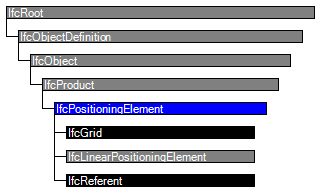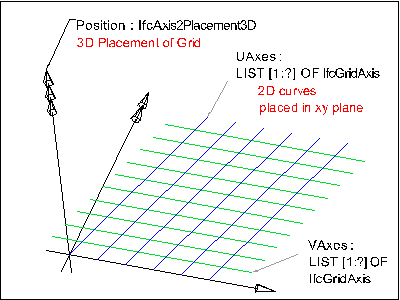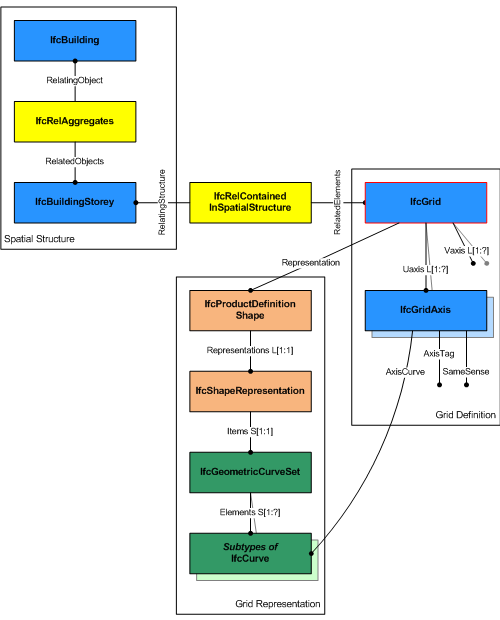Natural language names
 | Positioning Element |
Change log
| Item | SPF | XML | Change | Description | IFC4x1 Release Candidate 1 |
|---|---|---|---|---|
| IfcPositioningElement | ADDED |
Semantic definitions at the entity
Entity definition
New and abstract entity definition for positioning and annotating elements that are used to position other elements relatively.
EXAMPLE A grid is a positioning element to position building components mainly in vertical structures, an alignment is a linear positioning element to position geographic and civil elements mainly in infrastructure works.
EXAMPLE An alignment is a linear positioning element for using a linear referencing method to position other items. See ISO 19148 “Linear referencing” for general information about linear referencing methods and expressions.
Attribute definitions
| # | Attribute | Type | Cardinality | Description | G |
|---|---|---|---|---|---|
| ContainedInStructure | IfcRelContainedInSpatialStructure @RelatedElements | S[0:1] | Relationship to a spatial structure element, to which the positioning element is primarily associated.
IFC2x CHANGE The inverse relationship has been added to IfcGrid with upward compatibility IFC4 CHANGE The inverse relationship has been promoted from IfcGrid to this new supertype with upward compatibility | X |
Formal Propositions
| Rule | Description |
|---|---|
| HasPlacement | The placement for the grid has to be given. |
Inherited definitions from supertypes
Entity inheritance

Attribute inheritance
| # | Attribute | Type | Cardinality | Description | G |
|---|---|---|---|---|---|
| IfcRoot | |||||
| 1 | GlobalId | IfcGloballyUniqueId | Assignment of a globally unique identifier within the entire software world. | X | |
| 2 | OwnerHistory | IfcOwnerHistory | ? |
Assignment of the information about the current ownership of that object, including owning actor, application, local identification and information captured about the recent changes of the object,
NOTE only the last modification in stored - either as addition, deletion or modification. IFC4 CHANGE The attribute has been changed to be OPTIONAL. | X |
| 3 | Name | IfcLabel | ? | Optional name for use by the participating software systems or users. For some subtypes of IfcRoot the insertion of the Name attribute may be required. This would be enforced by a where rule. | X |
| 4 | Description | IfcText | ? | Optional description, provided for exchanging informative comments. | X |
| IfcObjectDefinition | |||||
| HasAssignments | IfcRelAssigns @RelatedObjects | S[0:?] | Reference to the relationship objects, that assign (by an association relationship) other subtypes of IfcObject to this object instance. Examples are the association to products, processes, controls, resources or groups. | X | |
| Nests | IfcRelNests @RelatedObjects | S[0:1] | References to the decomposition relationship being a nesting. It determines that this object definition is a part within an ordered whole/part decomposition relationship. An object occurrence or type can only be part of a single decomposition (to allow hierarchical strutures only).
IFC4 CHANGE The inverse attribute datatype has been added and separated from Decomposes defined at IfcObjectDefinition. | X | |
| IsNestedBy | IfcRelNests @RelatingObject | S[0:?] | References to the decomposition relationship being a nesting. It determines that this object definition is the whole within an ordered whole/part decomposition relationship. An object or object type can be nested by several other objects (occurrences or types).
IFC4 CHANGE The inverse attribute datatype has been added and separated from IsDecomposedBy defined at IfcObjectDefinition. | X | |
| HasContext | IfcRelDeclares @RelatedDefinitions | S[0:1] | References to the context providing context information such as project unit or representation context. It should only be asserted for the uppermost non-spatial object.
IFC4 CHANGE The inverse attribute datatype has been added. | X | |
| IsDecomposedBy | IfcRelAggregates @RelatingObject | S[0:?] | References to the decomposition relationship being an aggregation. It determines that this object definition is whole within an unordered whole/part decomposition relationship. An object definitions can be aggregated by several other objects (occurrences or parts).
IFC4 CHANGE The inverse attribute datatype has been changed from the supertype IfcRelDecomposes to subtype IfcRelAggregates. | X | |
| Decomposes | IfcRelAggregates @RelatedObjects | S[0:1] | References to the decomposition relationship being an aggregation. It determines that this object definition is a part within an unordered whole/part decomposition relationship. An object definitions can only be part of a single decomposition (to allow hierarchical strutures only).
IFC4 CHANGE The inverse attribute datatype has been changed from the supertype IfcRelDecomposes to subtype IfcRelAggregates. | X | |
| HasAssociations | IfcRelAssociates @RelatedObjects | S[0:?] | Reference to the relationship objects, that associates external references or other resource definitions to the object.. Examples are the association to library, documentation or classification. | X | |
| IfcObject | |||||
| 5 | ObjectType | IfcLabel | ? |
The type denotes a particular type that indicates the object further. The use has to be established at the level of instantiable subtypes. In particular it holds the user defined type, if the enumeration of the attribute PredefinedType is set to USERDEFINED.
| X |
| IsDeclaredBy | IfcRelDefinesByObject @RelatedObjects | S[0:1] | Link to the relationship object pointing to the declaring object that provides the object definitions for this object occurrence. The declaring object has to be part of an object type decomposition. The associated IfcObject, or its subtypes, contains the specific information (as part of a type, or style, definition), that is common to all reflected instances of the declaring IfcObject, or its subtypes.
IFC4 CHANGE New inverse relationship, change made with upward compatibility for file based exchange. | X | |
| Declares | IfcRelDefinesByObject @RelatingObject | S[0:?] | Link to the relationship object pointing to the reflected object(s) that receives the object definitions. The reflected object has to be part of an object occurrence decomposition. The associated IfcObject, or its subtypes, provides the specific information (as part of a type, or style, definition), that is common to all reflected instances of the declaring IfcObject, or its subtypes.
IFC4 CHANGE New inverse relationship, change made with upward compatibility for file based exchange. | X | |
| IsTypedBy | IfcRelDefinesByType @RelatedObjects | S[0:1] | Set of relationships to the object type that provides the type definitions for this object occurrence. The then associated IfcTypeObject, or its subtypes, contains the specific information (or type, or style), that is common to all instances of IfcObject, or its subtypes, referring to the same type.
IFC4 CHANGE New inverse relationship, the link to IfcRelDefinesByType had previously be included in the inverse relationship IfcRelDefines. Change made with upward compatibility for file based exchange. | X | |
| IsDefinedBy | IfcRelDefinesByProperties @RelatedObjects | S[0:?] | Set of relationships to property set definitions attached to this object. Those statically or dynamically defined properties contain alphanumeric information content that further defines the object.
IFC4 CHANGE The data type has been changed from IfcRelDefines to IfcRelDefinesByProperties with upward compatibility for file based exchange. | X | |
| IfcProduct | |||||
| 6 | ObjectPlacement | IfcObjectPlacement | ? | Placement of the product in space, the placement can either be absolute (relative to the world coordinate system), relative (relative to the object placement of another product), or constraint (e.g. relative to grid axes). It is determined by the various subtypes of IfcObjectPlacement, which includes the axis placement information to determine the transformation for the object coordinate system. | X |
| 7 | Representation | IfcProductRepresentation | ? | Reference to the representations of the product, being either a representation (IfcProductRepresentation) or as a special case a shape representations (IfcProductDefinitionShape). The product definition shape provides for multiple geometric representations of the shape property of the object within the same object coordinate system, defined by the object placement. | X |
| ReferencedBy | IfcRelAssignsToProduct @RelatingProduct | S[0:?] | Reference to the IfcRelAssignsToProduct relationship, by which other products, processes, controls, resources or actors (as subtypes of IfcObjectDefinition) can be related to this product. | X | |
| IfcPositioningElement | |||||
| ContainedInStructure | IfcRelContainedInSpatialStructure @RelatedElements | S[0:1] | Relationship to a spatial structure element, to which the positioning element is primarily associated.
IFC2x CHANGE The inverse relationship has been added to IfcGrid with upward compatibility IFC4 CHANGE The inverse relationship has been promoted from IfcGrid to this new supertype with upward compatibility | X | |
Definitions applying to General Usage
Concept usage
Placement
The Product Local Placement concept applies to this entity.
The local placement for IfcGrid is defined in its supertype IfcProduct. It is defined by the IfcLocalPlacement, which defines the local coordinate system that is referenced by all geometric representations.
- The PlacementRelTo relationship of IfcLocalPlacement shall point (if given) to the local placement of the same IfcSpatialStructureElement, which is used in the ContainedInStructure inverse attribute, or to a spatial structure element at a higher level, referenced by that.
- If the relative placement is not used, the absolute placement is defined within the world coordinate system.
Footprint Geometry
The FootPrint Geometry concept template applies to this entity as shown in Table 58.
| ||
Table 58 — IfcPositioningElement FootPrint Geometry |
The 2D geometric representation of IfcGrid is defined using the 'GeometricCurveSet' geometry. The following attribute values should be inserted
- IfcShapeRepresentation.RepresentationIdentifier = 'FootPrint'.
- IfcShapeRepresentation.RepresentationType = 'GeometricCurveSet' .
The following constraints apply to the 2D representation:
- The IfcGeometricCurveSet shall be an (and the only) Item of the IfcShapeRepresentation. It should contain an IfcGeometricCurveSet containing subtypes of IfcCurve, each representing a grid axis. Applicable subtypes of IfcCurve are: IfcPolyline, IfcCircle, IfcTrimmedCurve (based on BaseCurve referencing IfcLine or IfcCircle), and IfcOffsetCurve2D.
- Each subtype of IfcCurve may have a curve style assigned, using IfcStyledItem referencing IfcCurveStyle.
- Optionally the grid axis labels may be added as IfcTextLiteral, and they may have text styles assigned, using IfcStyledItem referencing IfcTextStyle.

|
As shown in Figure 31, the IfcGrid defines a placement coordinate system using the ObjectPlacement. The XY plane of the coordinate system is used to place the 2D grid axes. The Representation of IfcGrid is defined using IfcProductRepresentation, referencing an IfcShapeRepresentation, that includes IfcGeometricCurveSet as Items. All grid axes are added as IfcPolyline to the IfcGeometricCurveSet. |
|
Figure 164 — Grid layout |

|
As shown in Figure 32, the attributes UAxes and VAxes define lists of IfcGridAxis within the context of the grid. Each instance of IfcGridAxis refers to the same instance of IfcCurve (here the subtype IfcPolyline) that is contained within the IfcGeometricCurveSet that represents the IfcGrid. |
|
Figure 165 — Grid representation |
mvdXML Specification
<?xml version="1.0"?>
<ConceptRoot xmlns:xsi="http://www.w3.org/2001/XMLSchema-instance" xmlns:xsd="http://www.w3.org/2001/XMLSchema" uuid="c8f895c7-05da-40c4-9e55-63c9f6ca7a7a" name="IfcPositioningElement" status="sample" applicableRootEntity="IfcPositioningElement">
<Applicability uuid="00000000-0000-0000-0000-000000000000" status="sample">
<Template ref="efa174fb-e84b-4840-9326-7e79d5767b6f" />
<TemplateRules operator="and" />
</Applicability>
<Concepts>
<Concept uuid="36f7221a-c8c8-44d5-9095-fc968d32726d" name="Placement" status="sample" override="false">
<Template ref="cbe85b5f-7912-4a43-8bb7-1e63bf40b26d" />
</Concept>
<Concept uuid="17146158-fc6e-46ec-8f21-c7f004672eb1" name="Footprint Geometry" status="sample" override="false">
<Template ref="4f5777d7-68e9-459c-aa2c-46adf3e88d31" />
<TemplateRules operator="and">
<TemplateRule Parameters="" />
</TemplateRules>
</Concept>
</Concepts>
</ConceptRoot>
Concept inheritance
| # | Concept | Template | Model View |
|---|---|---|---|
| IfcRoot | |||
| Identity | Software Identity | General Usage | |
| Revision Control | Revision Control | General Usage | |
| IfcObjectDefinition | |||
| Classification Association | Classification Association | General Usage | |
| IfcObject | |||
| Object User Identity | Object User Identity | General Usage | |
| Object Predefined Type | Object Predefined Type | General Usage | |
| Object Typing | Object Typing | General Usage | |
| Property Sets for Objects | Property Sets for Objects | General Usage | |
| Property Sets with Override | Property Sets with Override | General Usage | |
| IfcProduct | |||
| Product Placement | Product Placement | General Usage | |
| Product Geometric Representation | Product Geometric Representation | General Usage | |
| IfcPositioningElement | |||
| Placement | Product Local Placement | General Usage | |
| Footprint Geometry | FootPrint Geometry | General Usage | |
Formal representations
XML Specification
<xs:element name="IfcPositioningElement" type="ifc:IfcPositioningElement" abstract="true" substitutionGroup="ifc:IfcProduct" nillable="true"/>
<xs:complexType name="IfcPositioningElement" abstract="true">
<xs:complexContent>
<xs:extension base="ifc:IfcProduct"/>
</xs:complexContent>
</xs:complexType>
EXPRESS Specification
ENTITY IfcPositioningElement
ABSTRACT SUPERTYPE OF(ONEOF(IfcGrid, IfcLinearPositioningElement, IfcReferent))
SUBTYPE OF (IfcProduct);
INVERSE
ContainedInStructure : SET [0:1] OF IfcRelContainedInSpatialStructure FOR RelatedElements;
WHERE
HasPlacement : EXISTS(SELF\IfcProduct.ObjectPlacement);
END_ENTITY;

 Instance diagram
Instance diagram Link to this page
Link to this page